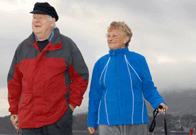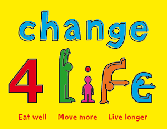Active life
Benefits of an active life - adults

How much activity should adults do?
For general health benefit, this should be at least 30 minutes a day. This can be done in short bouts of 10 or 15 minutes at a time. It should be moderate intensity physical activity on five or more days each week.
It is important for older people to keep moving and retain their mobility through daily activity. Activities that help improve strength, co-ordination and balance are very beneficial. Activities would include, exercise sessions, walking and gym.
You may have been very active when you were younger, but the benefits of that are not stored. As soon as you stop being physically active the benefits also stop. Therefore, physical activity needs to continue in to old age.
Why is it important for older people to be active?
As well as physical benefits, it can improve social, emotional and mental well-being, reduce anxiety and enhance mood. Taking part in regular activity can help you meet people and make new friends.
Being physically active can help older people maintain functional ability, independence and reduce the risk of falling. It can also help prevent and manage diseases and conditions such as heart disease, type 2 diabetes and stroke.
Doing regular activity, particularly structured exercise sessions can help slow down the loss of bone, muscle strength and power. It can also help maintain or improve balance, endurance and mobility.
Remaining physically active as an adults and in to old age can help maintain independence. Daily routines involving walking to local shops may mean less reliance on others and help with social and community interaction.
What type of activity should older people be doing?
It should include strength, balance and co-ordination exercises, as well as endurance activities like walking. This helps you to keep ability and confidence to carry out daily tasks like:
- getting shopping;
- lifting and carrying things;
- bathing and dressing.
Dancing, structured exercise sessions, swimming and walking are all great activities to achieve this.
Benefits of an active life - children and young people

How much physical activity should children and young people be doing?
At least 60 minutes of physical activity that gets their heart beating faster than usual, every day. This can be done in short bouts of varied activity in the day. It is important to include activities to improve muscle strength, flexibility and bone health.
Why is it important for children to be active?
Being active during childhood will help them develop a positive habit that becomes a way of life in to adulthood. This, along with a good diet, can help them keep a healthy weight. It can also help to protect them from life-threatening diseases, like heart disease, diabetes and cancer.
Also, being more active can help children find a sport or activity they really enjoy. Maybe they will have a talent for in. Taking part can help them make new friends, be more confident, improve self esteem, learn new skills and time management. This will all help them later in life.
What activity should children be doing?
A variety of activity is important at this stage. Things like running, jumping, ball games and gymnastics put stress on the bones and help develop and improve bone health. Active play including climbing, rough and tumble and carrying will help develop and maintain muscular fitness and flexibility. All movement like walking to and from (or part way) school, helps keep energy balance and prevent weight gain. A variety of activities and intensities will be fun, enjoyable, improve skills and give a range of health benefits.

Our fitness memberships offer a great range of health and fitness activities at different centres across Calderdale.

Eat well, move more, live longer, find out more through Change4Life|![]()
